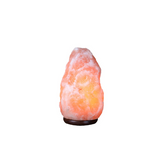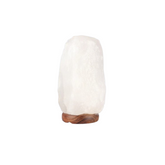Is Himalayan Salt Really Healthier? Debunking Common Myths
Is Himalayan Salt Really Healthier? Debunking Common Myths
Introduction: The Pink Salt Phenomenon
Over the past decade, Himalayan pink salt has grown in popularity, often hailed as a miracle ingredient with superior health benefits. Found in grocery aisles, spa treatments, and even salt lamps, this rosy-hued mineral is marketed as a healthier alternative to regular table salt. But how much of that reputation is backed by science, and how much is just clever branding?
This article aims to address the core question: Is Himalayan salt really healthier? We’ll break down the health myths, assess scientific evidence, and compare sodium content and other elements to give you a complete picture.
What Is Himalayan Pink Salt?
Mined from the ancient Khewra Salt Mine in Pakistan, Himalayan salt is a type of rock salt (halite) that gets its pink color from trace minerals like iron oxide. It's touted as being unrefined, free from additives, and packed with over 80 trace elements.
But despite its natural origins and aesthetic appeal, these properties don't necessarily make it healthier. Let’s explore why.
Myth #1: Himalayan Salt Contains 80+ Essential Minerals
The Claim
Advocates often cite the presence of over 80 minerals as a reason to switch to Himalayan salt.
The Truth
While technically true, most of these trace minerals are present in extremely small amounts—so tiny that they don’t contribute meaningful nutritional value. The main component of both table salt and Himalayan salt remains sodium chloride.
A 2011 study published in the Journal of Food Science and Technology showed that the mineral differences between various salts are negligible in terms of health impact.
Myth #2: Lower Sodium Content Makes It Safer
The Claim
Many believe that Himalayan salt is lower in sodium and, therefore, a better choice for people managing high blood pressure.
The Truth
Himalayan salt contains about 98% sodium chloride, nearly identical to table salt. The variation in sodium content is not enough to make a significant health difference.
Instead, health professionals recommend overall sodium reduction, regardless of salt type. The World Health Organization (WHO) advises limiting daily sodium intake to less than 2,000 mg.
Myth #3: It’s Detoxifying and Improves pH Balance
The Claim
Some marketing materials suggest that Himalayan salt can detoxify the body, balance pH levels, or improve hydration.
The Truth
There is no scientific evidence supporting these claims. Your body already has highly efficient organs like the liver and kidneys to handle detoxification. As for pH balance, your body regulates it tightly through buffer systems—dietary salt, pink or not, has minimal influence.
“These are baseless claims used to sell a product. No peer-reviewed evidence supports Himalayan salt as a detoxifying agent.” — Registered Dietitian Nutritionist, Emily Kyle, RDN
Nutritional Comparison: Himalayan Salt vs. Table Salt
| Feature | Himalayan Salt | Regular Table Salt |
|---|---|---|
| Sodium Content | ~98% | ~97-99% |
| Additives | None | Often contains anti-caking agents, iodine |
| Trace Minerals | 1-2% (iron, magnesium, zinc) | Minimal |
| Iodine Content | None (unless iodized) | Usually iodized |
| Texture | Coarse, crystals | Fine, powdery |
Note: Iodine is crucial for thyroid function, and a deficiency can lead to goiter. Switching to Himalayan salt exclusively may increase your risk of iodine deficiency if you don’t consume enough from other dietary sources.
The Marketing Machine Behind the Myths
Much of the health halo around Himalayan salt comes from strategic marketing that blends natural wellness trends with half-truths. Its luxurious pink hue, "hand-harvested" appeal, and association with ancient practices make it an easy sell.
But as consumers, it’s vital to separate aesthetic appeal from scientific fact.
So, Is Himalayan Salt Healthier?
Based on the evidence:
- It’s not significantly lower in sodium than table salt.
- It lacks iodine, a vital nutrient added to regular salt.
- The trace minerals it contains are negligible in health impact.
In short, Himalayan pink salt is not healthier, just different. Its benefits are mostly cosmetic or culinary, not medicinal.
When Should You Choose Himalayan Salt?
- Culinary uses: It adds a unique flavor and texture to gourmet dishes.
- Aesthetic value: Its color and form are appealing in spa treatments or as décor.
- Natural preference: If you prefer unrefined products without additives, it’s a good choice—as long as you manage iodine intake elsewhere.
But for health reasons, there’s no major advantage over regular table salt.
Expert Recommendations
- Use Himalayan salt in moderation, just like table salt.
- Ensure your diet includes iodine-rich foods like seafood, dairy, or iodized salt.
- Don’t rely on pink salt for detoxification or mineral supplementation.
“Salt is salt. The best kind is the one that fits your taste, dietary needs, and lifestyle.” — Dr. Michael Greger, Physician & Author
Conclusion
While Himalayan pink salt has its place in kitchens and spas alike, its health benefits are largely overstated. If you enjoy its flavor and appearance, go ahead and use it—just don’t buy into the myths that it’s a miracle health food.
For a deep dive into the broader topic of Himalayan salt, check out our Complete Guide to Himalayan Pink Salt: Origins, Minerals, and Everyday Uses.





